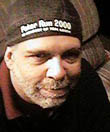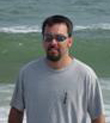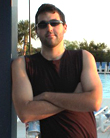|
|
 
|
|
Author
|
Topic: Here comes Hurricane Jeanne!
|
Thomas Procyk
Phenomenal Film Handler

Posts: 1842
From: Royal Palm Beach, FL, USA
Registered: Feb 2002
|
 posted 09-25-2004 08:49 AM
posted 09-25-2004 08:49 AM




Hello all,
This will probably be one of my last posts for a while again while we deal with yet another hurricane. Latest reports show the eye of the storm passing over Metro Orlando (I'm about 5 miles from there) around 2pm on Sunday. Widespread damage and power outages are likely, and I don't know when I'll get internet back, either.
We're pretty much safe up here. The new apartment is facing the opposite direction of the wind, with buildings sheilding the other side. We've got plenty of water and a couple interior rooms to hide in.
Unfortunatley, the full force will hit just 20 miles away from my parents' house (West Palm Beach/Royal Palm Beach) who have sustained damage during the last one, Frances. They still plan to ride it out at home.
To all the Florida techers as well as Georgia, Alabama and the Carolinas, all we can do is pray. Pray for the terrorists to stop controlling the weather! ![[Smile]](smile.gif)
Take care all, and I'll check in as soon as possible.
Thomas.
| IP: Logged
|
|
|
|
|
|
|
|
|
|
Bruce McGee
Phenomenal Film Handler

Posts: 1776
From: Asheville, NC USA... Nowhere in Particular.
Registered: Aug 1999
|
 posted 09-27-2004 06:47 AM
posted 09-27-2004 06:47 AM




We here in the mountains of western NC are really getting tired of this. Hominy Creek, a tributary of the French Broad River, is still about 4 feet above its normal levels, and is still very muddy looking where it goes by my best friends home. His home got 7 feet of water, and lost 5 classic cars with Ivan. His wife is freaking again over this, and we might be unloading the house One More Time...
We are waiting to replace the motors and electronics on his furnace, A/C, washer, dryer, and several other electric things. The house used to have a finished basement. Never again. I'll be busy with motors, etc. around Thursday, I hope.
| IP: Logged
|
|
Jason Black
Phenomenal Film Handler

Posts: 1723
From: Myrtle Beach, SC, USA
Registered: Nov 2000
|
 posted 09-27-2004 12:06 PM
posted 09-27-2004 12:06 PM





Bruce,
I can only imagine the water levels you're seeing. While in Stecoah (Fontana/Deal's Gap), I watched the Stecoah Creek rise over a foot in less than 30 minutes! ![[Eek!]](eek.gif) While it was cool to see nature at it's finest, I could only wonder at the water levels on those areas downstream where the full brunt would be felt. I noticed that the water level at th ecreek at Magie Valley was really high and rushing as well. While on our only scenic ride Saturday, noticed that there were MANY downed power lines, washouts, slides and debris everywhere! I didn't think it was that bad where we were but I was wrong indeed. Part of Hwy 28 near Franklin was completly gone. Washed away into the river bank... Also saw several HUGE rocks that had slid into the road. NC DOT crews were drilling (to blast I guess?) the rock for removal. While it was cool to see nature at it's finest, I could only wonder at the water levels on those areas downstream where the full brunt would be felt. I noticed that the water level at th ecreek at Magie Valley was really high and rushing as well. While on our only scenic ride Saturday, noticed that there were MANY downed power lines, washouts, slides and debris everywhere! I didn't think it was that bad where we were but I was wrong indeed. Part of Hwy 28 near Franklin was completly gone. Washed away into the river bank... Also saw several HUGE rocks that had slid into the road. NC DOT crews were drilling (to blast I guess?) the rock for removal.
I thought living at the beach during a 'cane was bad. Seeing Ivan in the mtns made me see how bad it could be elsewhere... And power outtages... good Lord, everyone in the mtn regions shoudl have generators...
Hope you come thru ok Bruce. Hate to hear of your buddies losses. At least it was cars lost, not lives.. ![[Frown]](frown.gif)
| IP: Logged
|
|
|
|
|
|
|
|
|
|
|
|
Thomas Procyk
Phenomenal Film Handler

Posts: 1842
From: Royal Palm Beach, FL, USA
Registered: Feb 2002
|
 posted 09-29-2004 10:03 AM
posted 09-29-2004 10:03 AM




quote: Dean Kollet
My question is....when will this stop?
NEVER! Lookit:
New weather patterns turn Florida into a hurricane magnet
BY MARTIN MERZER
Knight Ridder Newspapers
MIAMI - (KRT) - Charley, Frances and Ivan. Three major hurricanes. Two assaults on Florida already and possibly a third by next week. Get used to it. This is the new normal.
Scientists say we are in a period of enhanced hurricane activity that could last for decades, ending a 24-year period of below average activity. They also say the law of averages has caught up with Florida, with a change in atmospheric steering currents turning the state into a hurricane magnet.
``People are suddenly alert, suddenly paying attention,'' said Stanley Goldenberg, a meteorologist with the National Oceanic and Atmospheric Administration's hurricane research division on Virginia Key. ``They can see now that we are in an active era. ... - People should realize that it is very unlikely that Frances is the last storm the U.S. will see this year.''
Which brings us to Hurricane Ivan.
Though subject to considerable error, long-range forecasts are consistently suggesting that Ivan will strike Jamaica on Friday and Cuba on Sunday as a vicious Category 4 hurricane. The outlook improved slightly for South Florida, but the southern half of the state remained in the five-day cone of probability.
When asked if Florida can endure another hurricane, Gov. Jeb Bush pointed Tuesday to a button he wore on his shirt. It said: ``I survived damn near everything.''
``We will survive whatever comes at us,'' he said. ``We're an incredibly resilient state. I'm not being defiant; I'm only suggesting we can meet this challenge.''
If Ivan hits the state, it will be the first time since 1964 that three hurricanes smacked Florida in the same year. And September and October tend to be among the most active months of the six-month hurricane season that ends Nov. 30.
``The season is still young,'' said Max Mayfield, director of the National Hurricane Center in West Miami-Dade County. ``It certainly seems from my perspective that we're in the active period that has been predicted. The only surprise is that Florida hasn't been hit more often in the last few years.''
A sobering thought: Between 1941 and 1950, seven major hurricanes - with winds higher than 110 mph - attacked Florida. ``And that doesn't include the other less powerful hurricanes,'' Goldenberg said. That 10-year period fell in the middle of a cycle of heightened activity that began in 1926 and persisted until 1970.
Now, the combination of complacency bred during a long lull between 1971 and 1994, the new hyperactivity since 1995 and the ongoing mega-development of Florida's coasts frightens emergency managers and scientists.
``The implications are much-increased damage when storms make landfall,'' Goldenberg said, ``and the potential for major loss of life in the event of an evacuation foul-up during a rapidly intensifying storm.''
He has more than academic interest in this. Goldenberg and his family were nearly killed when Hurricane Andrew crushed their South Miami-Dade home in 1992.
Research he later conducted with NOAA scientist Chris Landsea, private expert William Gray and others found distinct patterns of low-activity hurricane periods and high-activity periods, each of which endured for decades. These patterns, unrelated to the current concern over global warming, are caused by regular cycles of oceanic and atmospheric phenomena, such as unusually warm water in hurricane breeding grounds.
One period of ``hyperactivity'' ended in 1970 and was followed by a 24-year lull. The new period of heightened activity began in 1995 and could last for another 10 to 30 years, according to their report, which was peer-reviewed and published in 2001 in the prestigious journal Science.
In the last few years, and particularly this year, the depressing statistics related to the number, power and duration of storms appear to verify the report's depressing conclusions, especially when major hurricanes are considered.
This is significant because, though relatively few in number, major hurricanes - Category 3 or higher - cause 80 percent of all damage from tropical weather.
``We're not talking about stronger hurricanes than in the past,'' Goldenberg said. ``We're talking about more of the stronger hurricanes.''
The long-term average, including relatively quiet periods and busy periods, is 2.6 major hurricanes a year.
Between 1971 and 1994, only four years had more than two major hurricanes and none had more than three. Between 1995 and 2003, a much shorter period, seven years had three or more major hurricanes.
And we've already had four major storms this year - Alex, Charley, Frances and Ivan.
All the other numbers tell the same tale: total storms, total strength, total duration, Caribbean hurricanes, October and November hurricanes, each at least 100 percent - in some cases 500 or 1,000 percent - higher since the lull.
``That's a humongous increase,'' Goldenberg said. ``This is striking. This is not a little signal. It would be like saying the average temperature is 15 degrees warmer than last summer. It's huge. It's huge.''
Worse, atmospheric steering currents have changed to our disadvantage.
During the beginning of this active period, a persistent and beneficial bend in the jetstream carried hurricanes away from Florida. Now, that phenomenon had disappeared, replaced by a persistent ridge of high pressure over the Atlantic that is pushing them toward Florida.
What can you do?
Only one thing: Prepare.
``People should realize that, active year or slow year, we can still get hit,'' Goldenberg said. ``Remember, Andrew hit during a below-average year. The higher activity is just all the more reason to remind people that they can't let their guard down.''
(Herald correspondent Mary Ellen Klas contributed to this report.)
---
© 2004, The Miami Herald.
=TMP=
| IP: Logged
|
|
|
|
All times are Central (GMT -6:00)
|
|
Powered by Infopop Corporation
UBB.classicTM
6.3.1.2
The Film-Tech Forums are designed for various members related to the cinema industry to express their opinions, viewpoints and testimonials on various products, services and events based upon speculation, personal knowledge and factual information through use, therefore all views represented here allow no liability upon the publishers of this web site and the owners of said views assume no liability for any ill will resulting from these postings. The posts made here are for educational as well as entertainment purposes and as such anyone viewing this portion of the website must accept these views as statements of the author of that opinion
and agrees to release the authors from any and all liability.
|

 Home
Home
 Products
Products
 Store
Store
 Forum
Forum
 Warehouse
Warehouse
 Contact Us
Contact Us




 Printer-friendly view of this topic
Printer-friendly view of this topic





![[Smile]](smile.gif)

![[uhoh]](graemlins/uhoh.gif)

![[Big Grin]](biggrin.gif)
![[beer]](graemlins/beer.gif)


![[Eek!]](eek.gif) While it was cool to see nature at it's finest, I could only wonder at the water levels on those areas downstream where the full brunt would be felt. I noticed that the water level at th ecreek at Magie Valley was really high and rushing as well. While on our only scenic ride Saturday, noticed that there were MANY downed power lines, washouts, slides and debris everywhere! I didn't think it was that bad where we were but I was wrong indeed. Part of Hwy 28 near Franklin was completly gone. Washed away into the river bank... Also saw several HUGE rocks that had slid into the road. NC DOT crews were drilling (to blast I guess?) the rock for removal.
While it was cool to see nature at it's finest, I could only wonder at the water levels on those areas downstream where the full brunt would be felt. I noticed that the water level at th ecreek at Magie Valley was really high and rushing as well. While on our only scenic ride Saturday, noticed that there were MANY downed power lines, washouts, slides and debris everywhere! I didn't think it was that bad where we were but I was wrong indeed. Part of Hwy 28 near Franklin was completly gone. Washed away into the river bank... Also saw several HUGE rocks that had slid into the road. NC DOT crews were drilling (to blast I guess?) the rock for removal. ![[Frown]](frown.gif)





